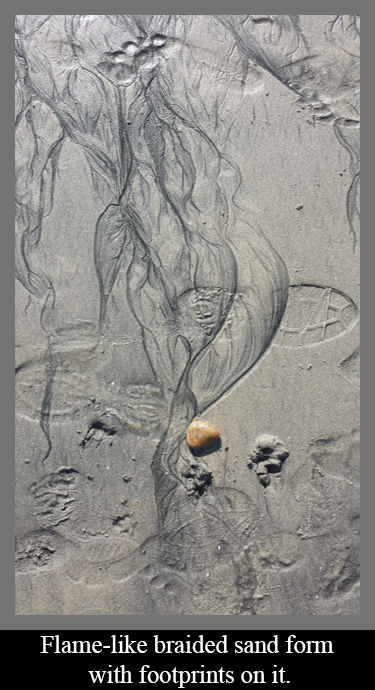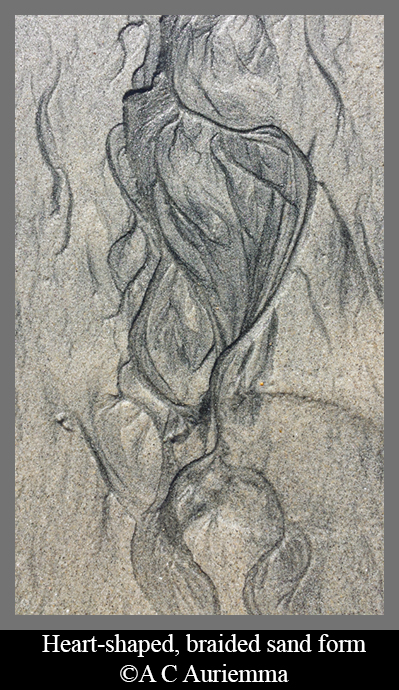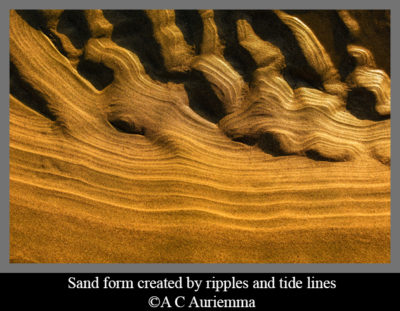 It all began with my grandmother, for two reasons. First, my grandmother loved to take pictures. From her, and my mother, I inherited an interest in seeing and creating artful scenes. Second, she loved the ocean. On a visit to her home in Oceanside California, I made my first awe-struck observation of sand patterns.
It all began with my grandmother, for two reasons. First, my grandmother loved to take pictures. From her, and my mother, I inherited an interest in seeing and creating artful scenes. Second, she loved the ocean. On a visit to her home in Oceanside California, I made my first awe-struck observation of sand patterns.
One sunny winter afternoon in 2014, we took  a trip down to Buccaneer Beach, a straight shot one mile west of my grandmother’s house. As she and the rest of our family relaxed on the beach and played in the waves, I took a stroll along the water’s edge. The tide was low. I walked on a slightly sloped part of the beach that, at that particular tide, was high enough to be above the breaking waves, but would have been covered at high tide.
a trip down to Buccaneer Beach, a straight shot one mile west of my grandmother’s house. As she and the rest of our family relaxed on the beach and played in the waves, I took a stroll along the water’s edge. The tide was low. I walked on a slightly sloped part of the beach that, at that particular tide, was high enough to be above the breaking waves, but would have been covered at high tide.
As I observed the sand I saw a wonderful thing. That part of the beach was covered with complex, flame-like forms. The contrast between the two colors of sand at the beach, one beige and the other black, made the carved-out grooves and curves pop! They were all over, and people were just waking over them, oblivious to the beauty they were destroying under their feet! In truth, the waves and the tide would destroy the patterns soon enough, but still, the beach-goers were not aware of these amazing creations right in plain sight. I found out later that what I had seen were spectacular braided sand forms are similar to what happens in relatively-flat river plane. More on that later. That day set down the first speck of an idea around which would crystallize my drive to understand and create art from sand patters.
 After taking photos on several more visits to Oceanside, I made another discovery. At the end of 2014, I decided to visit Limantour Beach at Reyes National Seashore for a few days to walk by the ocean and take pictures. On the three-mile hike from one end of the beach to the other, to my surprise I encountered the same sorts of sand patterns I observed at Buccaneer Beach, but also discovered a fantastic array of different types of patterns. Water flowing over low-tide sand bars forged some, many based of facets of ripple patterns. Wind blowing around drift wood or dunes created others.
After taking photos on several more visits to Oceanside, I made another discovery. At the end of 2014, I decided to visit Limantour Beach at Reyes National Seashore for a few days to walk by the ocean and take pictures. On the three-mile hike from one end of the beach to the other, to my surprise I encountered the same sorts of sand patterns I observed at Buccaneer Beach, but also discovered a fantastic array of different types of patterns. Water flowing over low-tide sand bars forged some, many based of facets of ripple patterns. Wind blowing around drift wood or dunes created others.  The tide waters cut or fed many of the patterns. I decided to dedicate myself to the project making art photographs of nature’s sand creations and focus mostly on Limantour Beach.
The tide waters cut or fed many of the patterns. I decided to dedicate myself to the project making art photographs of nature’s sand creations and focus mostly on Limantour Beach.
At the same time as I was enjoying the beauty of sand patterns, my curiosity led me to wonder: how are these patterns formed? To satisfy my interest, I started to read books and articles, and call up researches to ask questions. As a result, I amassed an intriguing web of answers and unanswered questions, all relating to the granular phenomena that I was seeing and including in my photographs.

Witnessing the ephemeral grace of sand patterns made me contemplate their similarities to life and other part of nature. I began to collect their thoughts as well.
Out of all of this comes Tongues and Grooves and other Evidence of Flow. It is an unfolding odyssey of beauty and curiosity, of understanding and wonder. Please join me.

Leave A Comment